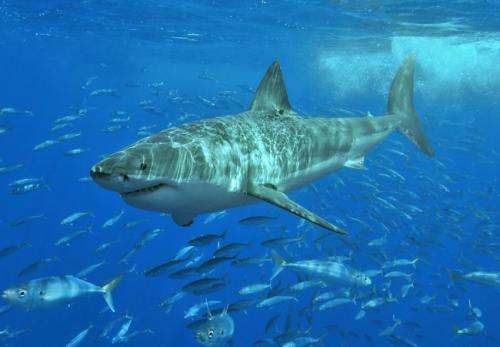Great white shark at Isla Guadalupe, Mexico, August 2006. Credit: Terry Goss/Wikipedia
Researchers have discovered a "dramatic increase" in the number of great white sharks swimming in Monterey Bay in recent years, including an area off Santa Cruz County where a surfer was killed last year, according to a new study published Tuesday.
Juvenile great white sharks—younger animals that are between 5 and 9 feet long—that traditionally concentrated in warm waters off northern Mexico and Southern California have moved north since 2014 as water temperatures have warmed, the study found.
Where once there were no juvenile white sharks spotted in the ocean between Manresa State Beach in Aptos and New Brighton State Beach in Capitola, now there are dozens seen every year, according to research from scientists at the Monterey Bay Aquarium, Duke University and California State University Long Beach. They swim there in groups between April and October, sometimes within a few yards of the shoreline and other features such as the "Cement Ship," a dilapidated boat off a pier at Seacliff State Beach. The sharks have been photographed regularly swimming near people, who often have no clue that the powerful creatures are so close by.
"I've seen sharks right under surfers—just a few feet away," said Chris Gularte, chief pilot with Specialized Helicopters, a tour company in Watsonville that regularly flies over the area. "When the water is warm and they come in the bay, you can see them swim near people all day long. Standup paddlers and kayakers will go right up to them and not realize they are there."
Gularte said he has not seen sharks from his helicopter in more famous Santa Cruz surfing spots such as Steamer Lane in Santa Cruz or Pleasure Point near Capitola. He said he has seen increasing numbers of the sharks off the Salinas River mouth and in San Francisco Bay.
In one tragic interaction last May, surfer Ben Kelly, 26, of Santa Cruz, was bitten about 100 yards from shore at Manresa State Beach in Aptos. The bite occurred behind his right knee, hit an artery and he bled to death. An investigation by state wildlife biologists found the shark was at least 10 feet long, bigger than the juveniles that have mostly congregated a few miles north.
Researchers said Tuesday that such attacks are rare. The influx of young sharks into Northern California, they said, is indicative of broad ocean changes underway due to climate changes that are affecting many species.
"What's been going on here has been really strange and different and unusual and not what we are used to," said Kyle van Houtan, chief scientist at the Monterey Bay Aquarium. "Monterey Bay is famous for cold water, kelp, otters, anchovies and whales. One thing that hasn't been here are juvenile white sharks. But in the past five years or so that has totally changed."
In Southern California, scientists last year tagged 53 juvenile great white sharks with transmitters, said Chris Lowe, a marine biologist with Cal State Long Beach. The tags send a signal when they come near four special buoys off Santa Barbara, Huntington Beach, Long Beach and San Clemente, and lifeguards on the beach receive a text alerting them sharks are in the area.
Lowe said he is working with officials from the Monterey Bay National Marine Sanctuary to try to establish a similar system from Seacliff State Beach to New Brighton State Beach, an area locals increasingly call "Shark Park."
He noted that great white sharks generally avoid people, and when they do bite somebody, it's almost never a sustained attack. It's a one-time bite, and then they leave.
"We really don't know the motivations of the sharks when these things happen," he said. "At best we think the shark made a mistake—they thought they were going after a fish or a seal."
After they are born, great white sharks stay in warm waters near the shore to feed on fish, rays and squid, said Sal Jorgensen, a marine researcher with UC Santa Cruz and co-author of the study, which was published in Scientific Reports, a peer-reviewed journal from the publishers of Nature.
After two or three years, they grow larger than 10 feet long and swim out to deeper, colder waters. Their teeth widen and become more serrated. They reach sizes of 17 to 19 feet long and eat sea lions and other marine mammals, often in colder waters in places such as the Farallon Islands.
The "shark nurseries" where they grow have typically been south of Santa Barbara County. But after the Pacific Ocean off the West Coast warmed considerably in an event known as "the Blob" in 2014, warmer conditions have moved northward, the scientists found. The warm conditions endured through El Niño events in 2015-16 and 2018-19 and continue today.
Tyler Fox, a pro surfer who has surfed in the Aptos area for years, said he has noticed a change.
"People are spotting them more and more in the water there," said Fox, publisher of Santa Cruz Waves magazine. "A couple of my buddies had one swim within 10 feet. The frequency of encounters has definitely increased."
Fox said surfers he knows did not go back to the area off Manresa Beach after Kelly's death. But now, particularly in the colder months when the sharks aren't believed to be around, surfers have returned. He said he surfed there Sunday.
"There are always fluke situations, but I believe in that particular zone, they are cruising around, hanging out and getting warm," he said. "They are not in hunting mode. They are not coming at you like you see in Jaws with a fin coming straight at you. I think it's fairly safe."
Journal information: Scientific Reports
©2021 MediaNews Group, Inc.
Distributed by Tribune Content Agency, LLC.
























